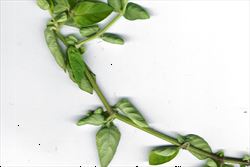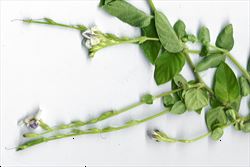Click on images to enlarge

stems and leaves (Photo: Forest and Kim Starr, USGS)

leaves and flower clusters (Photo: Forest and Kim Starr, USGS)
Scientific Name
Asystasia gangetica (L.) T. Anderson subsp. micrantha (Nees) Ensermu
Synonyms
Asystasia coromandeliana var. micrantha NeesAsystasia gangetica (L.) T. Anderson
Family
Acanthaceae
Common Names
Chinese violet, coromandel, creeping foxglove, Ganges primrose, Philippine violet
Origin
This sub-species is native to sub-Saharan Africa (i.e. Ethiopia, Kenya, Tanzania, Uganda, Cameroon, Equatorial Guinea, Zaire, Ivory Coast, Gambia, Ghana, Guinea, Guinea-Bissau, Liberia, Mali, Nigeria, Senegal, Sierra Leone, Togo, Angola, Malawi, Mozambique, Zambia, Zimbabwe, Botswana, Namibia, South Africa and Swaziland).
Cultivation
This plant has been cultivated as a garden ornamental, particularly in warmer regions.
Naturalised Distribution
Locally naturalised in eastern Australia (i.e. in the coastal districts of central New South Wales and in south-east Queensland, currently not very widespread. So far, populations have been detected at Newcastle and at nearby Anna Bay and Fern Bay.
It may also be present amongst populations of Asystasia gangetica in northern Australia, as not all states recognise subspecies of this species. Also naturalised overseas in south-eastern Asia (i.e. Malaysia, Indonesia and Papua New Guinea), tropical America and Oceania.
Habitat
A potential weed of distrubed sites, waste areas, roadsides, crops, plantations, open woodlands, forest margins and coastal habitats in the warmer temperate, sub-tropical and tropical regions of Australia. It is currently found mainly on coastal sandy soils in the warmer temperate regions of New South Wales.
Habit
A long-lived (i.e. perennial) herbaceous plant that is usually a mat-forming creeper (i.e. prostrate or decumbent) growing less than 0.5 m tall. However, it can also sprawl or clamber over supporting vegetation to a height of 3 m or more.
Distinguishing Features
-
a long-lived mat-forming creeper or sprawling plant growing over supporting vegetation.
-
its stems are lightly hairy and develop roots where the joints come into contact with moist soil.
-
its paired leaves (2.5-8 cm long and 1.5-4 cm wide) are egg-shaped in outline and borne on stalks 8-20 mm long.
-
its tubular flowers (1.8-3.5 cm long) are borne in elongated clusters and have five spreading petal lobes (about 3 cm across).
-
these petals are mostly white in colour, but the bottom petal lobe has purple blotches arranged in two parallel lines.
-
its elongated or club-shaped capsules (13-36 mm long) contain four seeds.
Stems and Leaves
The stems are lightly hairy (i.e. sparsely pubescent) and develop roots (i.e. adventitious roots) where the joints (i.e. nodes) come into contact with moist soil.
The bright green leaves are arranged in opposite pairs along the stems and are also sparsely hairy (i.e. sparsely pubescent). These leaves (2.5-8 cm long and 1.5-4 cm wide) are egg-shaped in outline (i.e. ovate), heart-shaped (i.e. cordate) or oval (i.e. elliptic) in shape and have paler green undersides. They are borne on stalks (i.e. petioles) 8-20 mm long and have entire or slightly bluntly toothed (i.e. crenate) margins with pointed tips (i.e. acute apices).
Flowers and Fruit
The tubular flowers (1.8-3.5 cm long and about 3 cm across) are borne in elongated clusters (i.e. racemes) up to 10 cm long and are arranged along one-side of the stem. The flowers are borne on short stalks (i.e. pedicels) 2-3 mm long and have five sepals (7-9 mm long) that are fused together at the base (i.e. into a clayx tube). The petals are also fused into a tube (i.e. corolla tube) for most of their length (up to 25 mm) and have five spreading lobes (i.e. corolla lobes). These petals are mostly white in colour, but the bottom petal lobe has purple blotches in two parallel lines on its inside. The flowers also have four yellow stamens and an ovary topped with a long style that ends in a tiny two-lobed stigma. Flowers and fruit can be present year round, but are mainly produced during warmer and wetter conditions.
The fruit are elongated or club-shaped (i.e. clavate) capsules and contain four seeds. These capsules (13-36 mm long) have two compartments (i.e. two seeds in each compartment) and turn from green to bown in colour as they mature. The flattened seeds (about 5 mm long and 1 mm wide) are bone-coloured to brownish-black.
Reproduction and Dispersal
This species reproduces by seed and also vegetatively via stem segments.
The seeds are explosively released from the capsules when they are mature and can be propelled short distances. The trailing stems produce roots when they come into contact with moist soil and can spread an infestation laterally. The main method of dispersal over long distances is by human activities (e.g. mining, gardening, landscaping, roadworks and the dumping of garden waste), though spread may be mitigated by water and animals.
Environmental Impact
Chinese violet (Asystasia gangetica subsp. micrantha) is on the Alert List for Environmental Weeds. This is a list of invasive plants that are in the early stages of establishment in Australia, and are thought to threaten biodiversity and have the potential to seriously degrade native ecosystems. This species forms dense mats of vegetation that smother other ground plants and displaces native flora. It also reduces the availability of habitat for native plants and animals and therefore reduces biodiversity. It is regarded as an important emerging environmental weed in New South Wales.
Other Impacts
Chinese violet (Asystasia gangetica subsp. micrantha) is a weed of rubber, oil palm and coffee plantations, and other crops, in south-eastern Asia. If it became widely established it could potentially affect summer crops and plantation crops in northern Australia. As it competes effectively for soil nutrients, it could reduce the productivity and increase the management costs of crops in northern agricultural regions.
Legislation
This species is declared under legislation in the following states and territories:
- New South Wales: Class 1 - a state prohibited weed. The presence of the weed on land must be notified to the local control authority and the weed must be fully and continuously suppressed and destroyed (throughout the entire state).
- Western Australia: Unassessed - this species is declared in other states or territories and is prohibited until assessed via a weed risk assessment (throughout the entire state).
Management
For information on the management of this species see the following resources:
- the New South Wales Department of Primary Industries Weed Alert on this plant, which is available online at http://www.dpi.nsw.gov.au.
Similar Species
Chinese violet (Asystasia gangetica subsp. micrantha) is very similar to another form of Chinese violet (i.e. Asystasia gangetica subsp. gangetica). These sub-species can be distinguished by the following differences:
- Asystasia gangetica subsp. micrantha has flowers that are mostly white in colour, but the bottom petal lobe has purple blotches in two parallel lines on its inside.
- Asystasia gangetica subsp. gangetica has flowers that are pink, mauve or purplish in colour with paler throats, or flowers that are entirely white or cream in colour with pale yellowish throats.
A native species (i.e. Asystasia australasica), which is only found in far northern Queensland, is also very similar.
Note: The entirely white-flowered form of Chinese violet (Asystasia gangetica subsp. gangetica) is sometimes also known as Asystasia gangetica 'Alba'.

